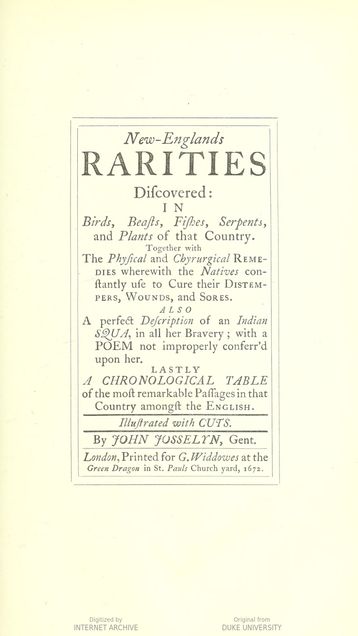John Josselyn, New-Englands rarities discovered: in birds, beasts, fishes, serpents, and plants of that country: together with the physical and chyrurgical remedies wherewith the natives constantly use to cure their distempers, wounds, and sores (London, 1672)

Claire Gola, Lauren Kaye, Katarina Soto
Our research paper is devoted to the exploration of John Josselyn’s New-Englands Rarities Discovered as both a physical object as well as the specific findings and resources within the book. With the novel being so dense with material and Josselyn’s findings, we will work to highlight what we found to be the most important parts. We begin with an introduction to the external aspects of the book such as the historical timeline, the background information on Josselyn himself, as well as how the book has been translated by the 19th century editor, Edward Tuckerman. We take this information a step further by looking at the text through the two perspectives of both Josselyn and Tuckerman, and therefore through both the seventeenth and nineteenth centuries. We then dive deeper into the findings within Josselyn’s book as we discover the differences of the native Indians’ use of specific resources versus the uses from the English, analyzing Tuckerman’s commentary on those resources along the way.
The goal of this paper is to explore the dichotomy between the Natives and the English cultures to someone who has no prior knowledge of this book. We mainly focus on three major aspects of his text: food, medicine, and the description of Natives at the end of the book. These are three extremely important areas to further explore and explain because they highlight the differences between these two cultures.
We begin with the food that is commonly eaten in New England; specifically, we dive into the use of oats on both the Native and English side. Even though these two societies may be eating the same type of grain, the way the food is prepared and eaten is unalike. We explore the description that Josselyn provides on the differences in food preparation and consumption, as well as Tuckerman’s insight on the oat dishes in the footnotes.
Secondly, we discuss the use of medicine and plants by the Natives and the English. New-Englands Rarities Discovered is the first written record on Native herbal medicine, and Josselyn emphasizes the importance of Native medicine in the complete title of his text (New-Englands Rarities Discovered … Together with the Physical and Chyrurgical Remedies wherewith the Natives Constantly use to Cure their Distempers, Wounds, and Sores). Josselyn takes the plant knowledge of Natives and addresses the methods of using certain plants, such as the white hellebore. We compare the botanical description that Josselyn provides of the white hellebore with that of Tuckerman; then, we discuss one of the native New England plants unknown to Josselyn, the “Humming-Bird Tree,” and address Tuckerman’s observations on that species. We also compare his overall description of Native medicine with other botanical writers of his time. The doctors and botanists look at and interpret the science of medicine in different ways, which we describe in further detail. We then return to Josselyn’s text, examining his diction and sketches (including diagrams of the unknown “Humming-Bird Tree” and skunk cabbage, as Josselyn refers to the white hellebore his description of the plant).
Lastly, we focus on one of the final sections of Josselyn’s book, “A Description of an Indian Squa.” “Squa” is a derogatory term for an Indian woman, and we briefly discuss the historical usage of the word and the manner at which Josselyn uses it. This is one of the only sections in his text where he describes his subject in several detailed paragraphs. We found it important to analyze his interpretation of the Indian community, especially since he dedicated an entire section to their description rather than a paragraph. Tuckerman writes a rather long footnote on his description of the Natives, comparing it to William Wood’s New Englands Prospect. We examine Tuckerman’s thoughts on Josselyn’s interpretation of Native women and their community, and we briefly inspect Wood’s notes in comparison.
Our paper discusses these specific details because we feel that they are the most telling of the relationship between the Natives and the English. There is an extensive amount of information in John Josselyn’s New-Englands Rarities Discovered regarding common flora and fauna of New England, but the goal of our paper is to provide a well-thought out narrative that is simple enough for our audience to follow. We believe that each of these sections, along with Tuckerman’s commentary, provides a substantial look into the book as a whole. We will conclude by going back to the history of the text, describing the process as to how the book made its way to the Massachusetts Historical Society.